In Memoriam
Bob Kuehn
In remembrance of Bob Kuehn, here are the following ...
- Obituary, Boston Globe
- Obituary, Vineyard Gazette by Sam Low, '64
- Remembrance, 6/5/09, at 45th reunion memorial service, Sam Low, '64
- A photo gallery of Bob's projects
- A remembrance by the founder of the Affordable Housing Institute
- A remembrance by Jeremy Wood, '64
- A remembrance by Joe Wishcamper, '64
- A remembrance by John Dobkin, '64
Also see an earlier op-ed article written by Bob in 2001 for the Boston Globe.
And finally, Joe Wishcamper wrote in June 2015 ... "Our friend and classmate Bob Kuehn died 9 years ago. He was single and without children, and left the bulk of his estate to a foundation which he established. The foundation created a fellowship program and has named the first class of Kuehn fellows who will work in nonprofit affordable-housing organizations in the Boston area. The intent of the program is to help train young housing professionals in hopes that some of them will carry on the kind of work that Bob did in his distinguished career. As you may know, there's also a Robert H. Kuehn Jr. Scholarship funded by Bob at the Yale School of Forestry and Environmental Studies. Both of these will help perpetuate the legacy of an extraordinary member of our class."
Robert Kuehn Jr., 63; helped develop mixed-income housing
Boston Globe, June 20, 2006
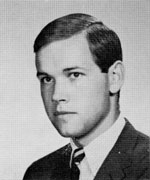
Bob Kuehn
"New Construction"
1964 graduation
At Robert H. Kuehn Jr's 60th birthday party in 2002, a photograph of him as a tall, slender young man was labeled "New Construction." Alongside it at the celebration in Harvard Square, a photo of a gray-bearded man wearing slightly rumpled clothing and the same smile was labeled "Historic Rehab."
The juxtaposition, colleagues said, aptly captured Mr. Kuehn, an award-winning developer, and the years he spent transforming historic buildings into mixed-income housing.
A longtime champion of affordable housing and mixed-use developments, Mr. Kuehn died of a heart attack Thursday at his Keen Development Corp. offices in Cambridge. He was 63.
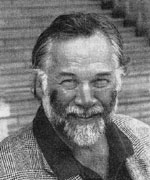
Bob Kuehn
"Historic Rehab"
"He was a giant in the field of affordable housing and community
development;' said Aaron Gornstein, executive director of the Citizens'
Housing and Planning Association, a Boston-based nonprofit advocacy group.
"He pioneered high quality, mixed- income housing in Massachusetts and made
it a national model for the rest of the country."
Boston is dotted with the projects that Mr. Kuehn and his company developed
for mixed-income housing, such as West End Place, Anderson Park, and
Anderson Place on Beacon Hill, 300 Summer St. in South Boston, and the Baker
Chocolate Factory in Dorchester.
Though many municipalities tend to have negative associations with
developers, Gornstein and others said, Mr. Kuehn was a favorite among many
citizens groups, having established himself as a community-oriented
developer who had an eye for making efficient use of spaces that had a
rich history.
Mr. Kuehn was drawn to complicated projects that required careful planning
and would often take on projects others thought to be impossible, such as
the old Chelsea Post Office, which became the Chelsea campus of Bunker Hill
Community College, and Building No. 114 in the Charlestown Navy Yard, which
he rehabilitated after much of it was destroyed in a fire.
Much of his ability to get these projects up and running was because of his
diplomatic, easy-going style, housing advocates said, which was appealing
to those with whom he had to work, including politicians.
Mr. Kuehn also liked to work on projects that helped redevelop and preserve
artist housing, such as Fenway Studios and Midway Studios.
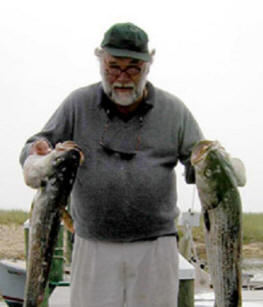
Over the years, he was on dozens of boards and committees, mostly revolving
around affordable housing and historic preservation. He was a former
president of Historic Massachusetts, a statewide nonprofit group dedicated
to increasing awareness of historic properties in Massachusetts. Several of
his projects won development awards, according to Mr. Kuehn's company.
When the state Community Preservation Act was signed into law in 2000,
allowing each community to decide whether to add a surcharge of up to 3
percent on property taxes to pay for affordable housing, historic
preservation, and open space, Mr. Kuehn eagerly responded to the queries of
cities and towns that adopted it.
He was born in Minneapolis and moved east to attend Yale University, from
which he received a bachelor's degree in 1964 and two master's degrees, one
in urban studies and another in architecture in 1968. He was a Fulbright
Scholar at the University of London in 1969.
Mr. Kuehn lectured at a number of local colleges, including Tufts
University and Massachusetts Institute of Technology.
He launched Keen Development Corp. in 1976, initially using Kuehn, but
found his name was often mispronounced. So he renamed his company Keen to
capture the correct pronunciation.
Mr. Kuehn leaves his brother Tom of Albuquerque.
A memorial service will be held at 2 pm tomorrow in the courtyard of West
End Place, one of the many buildings he helped to build.
Obituary for Robert Kuehn Jr.
by Sam Low, '64
Vineyard Gazette, June 20, 2006
On Wednesday, June 21st, hundreds of mourners filled the grassy
quadrangle at West End Place in downtown Boston to celebrate the life of
Robert H. Kuehn, one of this country's foremost developers of affordable
housing and a leading light in the rehabilitation of our nation's historic
buildings. It was a fitting location for such a gathering because it
embodied the sprit of Bob's lifelong crusade to discover and breathe life
back into places that had fallen into desuetude due to neglect and a lack of
historical sensitivity.
In the 1950s, Boston's West End was a vibrant working class community
celebrated in MIT sociologist Herbert Gans' famous book The Urban
Villagers. But with the advent of "urban renewal," the working class
neighborhood of triple deckers was torn down and replaced by luxury
apartments. The destruction of the West End and the psychological impact on
its dispossessed ‘urban villagers' became the lore of sociologists and urban
planners for the next quarter century. In 1994, Bob learned that a single
parcel of land might be available in the West End for mixed income housing.
He was fascinated by the prospect of bringing life back into the old
neighborhood. He thoroughly researched its history and he went so far as to
contact families who had formerly lived in the West End. Bob was so pleased
with the success of this project that he chose to live in West End Place (picture)
so when it came time to mourn his loss, it seemed the right location for it.
Bob Kuehn was born on October 27, 1942 in Minneapolis. He graduated from
Minneapolis North High School in 1960. He was President of the Student
Council and class valedictorian. He attended Yale University, graduated in
1964 and moved a few blocks down York Street to attend Yale's school of
architecture. Bob enjoyed designing buildings but soon realized that what
ultimately gets built has less to do with the architect than with the whims
of the money man, the developer. Combining this insight with a growing
concern that suitable places to live be provided for all Americans, Bob
decided to specialize in affordable housing. In 1968, he earned a double
degree - a master's in urban studies and another in architecture from Yale.
In 1969 he was a Fulbright Scholar at the University of London. As a thesis
project at Yale, Bob developed a computer program that analyzed the
available subsidies for building affordable housing, a tool that became the
basis for a national industry of syndication of investment in real estate
projects. He designed this program at a time when personal computers were a
distant dream, learning the early clunky languages that were used to
converse with huge mainframe machines attended by acolytes in
air-conditioned buildings. To learn the finesse of development, Bob spent
his early years as a consultant to developers — First Realty of Boston being
the most prominent - learning the trade first hand, before branching out on
his own.
Old unused buildings seemed to call to Bob. It was as if he could feel the
tremor of the machinery and the thump of worker's footsteps and he wanted to
— literally — bring those sounds back. In 1976, Bob founded
Keen Development
Corporation and began to specialize in the rehabilitation of historic
buildings and their conversion to mixed-income housing. He was especially
adept at finding innovative sources of funding and inventing new ways to
work with community organizations to achieve mutually beneficial goals.
One project that Bob spoke of almost constantly and always fondly was the
Baker Chocolate Factory in Dorchester Lower Mills, a gem from Boston's
industrial past. On the banks of the Neponset River, the factory made
chocolates in the 1800s and continued until the company relocated in 1964
when the buildings fell into disrepair for almost two decades. But Bob saw
the fading beauty of their ornate façades and towers and, in 1982, began
their renovation. Today, Baker Chocolate Factory (picture)
contains 133 apartments at moderate rents and has contributed significantly
to the revitalization of the surrounding neighborhood.
Bob was convinced that the life of any great town or city depended on the
vitality that artists brought to their community, and he worked hard to
create places for them to live and work. In Cambridge, for example, he
helped a community of artists purchase and renovate Fenway Studios. The
artists formed a group called "Artists for the Preservation of the Fenway
Studios" and when they could not find local banks willing to provide a
mortgage, he loaned them money to help keep the effort going and finally
secured a mortgage for them from a bank in Washington. The artists formed a
"not for profit" cooperative, the building was successfully renovated,
eventually placed on the National Register of Historic Places and has since
become a business model for future artists' cooperatives. Bob followed up
with other successful artists live/work projects (places where artists both
have their studios and reside) among them Midway studios and 300 Summer
Street in Boston's Fort Point neighborhood, Smith Lofts in Providence Rhode
Island and Kennedy Biscuit Lofts (picture)
in Cambridge (the birthplace of the famous Fig Newton).
Among Bob's most daunting projects was the renovation of one of Boston's
most infamous housing projects, Columbia Point. In 1985, Columbia Point had
become a crime ridden no man's land with only about 350 of the 1500
apartments still occupied. Bob and two other partners worked hand in hand
with a task force of committed local residents who believed in the vision of
converting the blighted development into mixed income housing.
Rehabilitation on this scale had never been tried before in Boston. The grid
of buildings was cleverly redesigned so that views were opened to Boston
Harbor and what was once a series of bland Stalag-like buildings was
converted to a neighborhood of mid-rise apartments and two to three story
townhouses. Now called Harbor Point, the successful mixed income community
comprises 1283 rental apartments.
Bob relished the challenge of complex projects that others thought
impossible, including the old Chelsea Post Office, now the Chelsea campus of
Bunker Hill Community College and Building #114 in the Charlestown Navy
Yard, thirty percent of which was destroyed by fire prior to Bob's
renovating it into 114 high tech laboratories for biomedical research, a
conference space and a waterfront café.
Bob was a teacher at heart, donating his time to worthy groups as well as
serving on the faculty of prestigious educational institutions. He was a
lecturer at the Tufts Urban and Environmental Policy Program and the MIT
Department of City Planning, a Research Associate at the Harvard Business
School and an instructor at the Yale Department of City Planning.
Bob was president of CHAPA
(Citizen's Housing and Planning Association) at the time of his death and
past president of Historic Massachusetts (now
Preservation
Massachusetts), two organizations that are leaders in providing decent,
safe and affordable housing and rehabilitating historic structures for
contemporary use. Bob also served as Vice-Chair of the Advisory Board of the
Massachusetts Community Preservation Act Coalition and on the National
Advisory Board of the
National Trust for Historic Preservation.
"He was such a great friend and counselor." said Wendy Nicholas, Director of
the Trust's Northeast Office. "He was always so willing to go anywhere in
the ten-state region that we serve to look at endangered historic properties
that we were trying to save even though they were usually white elephants!
He always had good counsel and advice for us and we loved to take him to
meet with people that we were trying to persuade to preserve older buildings
as he was such an articulate and passionate spokesperson. He was a pioneer
in taking old buildings and adapting them for new uses."
In 1990, Bob formed Hall Keen management with partners John and Denny Hall
to manage a growing portfolio of mixed-income residential properties as well
as artist lofts and commercial space. Fittingly, his Harvard Square office
was in a building the he rescued from decay and rehabbed into affordable
housing.
To relax, Bob played poker with a group of close friends, fished and flew
his single-engine airplane on trips between his homes in Maine, Boston,
Martha's Vineyard and Key West. In 1990 and 1993, he joined his brother Tom
— a professional pilot — and together they flew a small plane across the
United States.
"I'd guess Bob's idea of a perfect day would be to fly his plane to a remote
fishing site, catch some huge fish, eat them, and then play poker for five
hours with his friends while listening to the Red Sox on the radio," says
Dick Johnson, who grew up with Bob In Minneapolis and was a life-long
friend.
Bob first came to the Vineyard as my guest in 1960 (we were at Yale
together) and he returned often for visits until, in 1998, he purchased a
home in Harthaven. From that point on, the Vineyard was a favorite spot. He
loved to fish the shoals off Wasque and the grounds on the eastern edge of
the island. He became a savant of smoking bluefish and striped bass.
On the island, he quickly joined the efforts of prominent affordable housing
advocates. He was a founding member of the non-profit Island Affordable
Housing Development Corporation in 2001 which was transformed in 2004 into
the Island Housing Trust Corporation. He played an active role in the
formation of the Martha's Vineyard Housing Bank Coalition and also was a
board member and former vice president of the Island Affordable Housing
Fund.
"Bob was a gentle kind giant whose invaluable knowledge, expertise and
contributions to all committees will be so very much missed," said Dale
Julier, a board member of Island Housing Trust. "Bob really cared and
understood the complexities of what we were encountering almost better than
anyone. How often we deferred to him for advice. It is hard to imagine him
not here any longer."
For the past four years, Bob has been providing pro bono assistance
to Bridge Housing Corporation, in their efforts to build Bridge Commons,
thirty homes on a twenty-four acre parcel of land on State Road in Vineyard
Haven.
Island attorney Marcia Cini, who has worked with Bob in the affordable
housing and historic preservation trenches for almost twenty-five years,
recalls a moment when she asked Bob to serve as an expert witness in an
appeals trial for Bridge Housing. Bob braved inclement weather to fly his
plane to the island, landing as the fog was gathering in Vineyard Sound. "We
asked the judge to let him on first as the weather was closing in, he did a
fabulous job for us, and off he flew," Marcia remembers. "Bob was a
larger-than-life presence who has for decades freely donated the benefit of
his gift for clear, comprehensive analysis of affordable housing solutions
to the Martha's Vineyard as well as the greater Massachusetts community."
"Bob Kuehn was incredibly supportive of affordable housing on the Vineyard
as well as elsewhere," said Bridge Housing President, Dick Mezger. "He was
wise and experienced and skilled and always offered excellent advice and
insights. He provided confidence that we were headed in the right direction
and that we would succeed. He will be missed."
"Bob Kuehn was a tremendous force for affordable housing progress on
Martha's Vineyard," said John Abrams. "During the years we served together
as board members of the Island Affordable Housing Fund and the Island
Housing Trust and collaborated on several projects, his was a voice of
experience, confidence, optimism, and, always, great wit and grace. He was
unambiguous in his desire for action, impatient with bureaucracy and fear.
He knew where to go for good information, and he always looked for - and
usually found - the simple straight-ahead path. His legacy will continue to
grow as some of the projects he has lent advice to - like Bridge Housing and
Middle Line Road - get built and occupied. He would love to have been able
to see those dreams realized. Bob's contributions, and his tremendous
generosity of spirit, will not be forgotten."
In recognition of Bob's particular affection for the Penny Lane project in
Edgartown, the board of the Island Affordable Housing Fund will rename the
project in his honor.
Bob was an advisor to, among other prominent organizations, the National
Trust for Historic Preservation, the Massachusetts Housing Finance Agency,
the Architectural Conservation Trust, Boston Foundation for Architecture and
the Community Preservation Coalition. He was on the board of directors of
the Boston Architectural Center, the Citizens' Housing and Planning
Association, Historic Massachusetts, Inc, Massachusetts Cultural Council,
Massachusetts Special Commission on Historic Preservation and the Mayor's
Advisory Panel on Housing in Boston.
Bob received many awards during his productive life, including many
Preservation Awards from the Massachusetts Historical Commission, the Green
Seal Award from the Executive Office of Environmental Affairs, an Honor
Award from the New England Regional AIA, a Community Service Award from
Citizens Housing and Planning Association, the Paul E. Tsongas Award for
"Lifetime Achievement in Historic Preservation," the 25th Anniversary Award
from the Advisory Council on Historic Preservation and the Copley Society
Award for "Distinguished Service to the Arts."
Donations in Bob's memory can be made to Bob's Foundation, the Keen
Charitable Foundation at 2 University Road, P.O. Box 382589, Cambridge, MA
02238.
Bob is survived by his brother Thomas Kuehn of Albuquerque, New Mexico, his
sister in law, Cori and his nephew, Robert.
Memorial Service, Battell Chapel, June 5, 2009
Bob Kuehn was remembered at a Memorial Service in Battell Chapel on June 5, 2009 during our 45th reunion. Sam Low '64 was asked to write a Hawaiian chant and recite it at the service. Bob's nickname was Keenzo — as he is called in this chant.
Bob and Sam met at Trumbull College in 1961 where they shared an entryway. They remained friends for the rest of their lives. They owned two houses together and two boats, which attests to their ability to get along. When Bob died, he and Sam were sharing a house on Martha's Vineyard.
During their long association, Bob came to appreciate Sam's Hawaiian chants, given on the occasion of various marriages, birthdays, and other events. (Sam is part-Hawaiian and spends a lot of time in the islands.) So, in his will, Bob asked that Sam give "one of his ersatz Hawaiian chants" at his funeral. The word "ersatz" refers to the fact that Sam often made up the Hawaiian as he went along and that the chants were usually funny and often bawdy.
Over the years, however, as Sam spent more time in Hawaii exploring his own roots, he became more familiar with real chants and he began to compose them in real Hawaiian, borrowing from books of chants in his growing library. The chant that Sam gave for Bob at the 45th reunion is as accurate to the true Hawaiian as Sam could make it, both in words and in the technique of chanting. "I would never presume," Sam says, "to give such a chant in front of a Hawaiian audience, as chanting in the islands is only done by experienced chanters after long practice. But Bob asked, and I felt honored to do my best in the Battell Chapel at Yale." For more background on Sam you can visit his website at www.samlow.com.
Mele for Bob Kuehn: Keenzo
written and recited by Sam Low
He aikane, he punana na ke ona ona
Sweet indeed is a good friend
He hoa kui lima
A companion to walk with hand in hand
i ku'a na'u
Let me carry out your last wishes
Keenzo he pao'o lekei
like the leaping pao'o fish — you were never idle
‘ike ‘ia no ka loea i ke ku ahu
you are known by the many altars you built.
He puko'a kani ‘aina
You grew like a coral reef from a small beginning into a large island
He po'i na kai uli, kai ko'o ‘a'ohe hina puka'a
You stood in deep and rough sea like a coral rock
he la'au ku ho'o kahi, he lehua no ka'ala
You stood like a lone lehua tree in your wisdom
Kanu kanu, huna i ka meheu, I ka ma'awe alanui o kapu'ukolu
A private man, often guarding your inner thoughts
Niau kololani ka helena, huna na maka i ke aouli
Silently, quickly you departed to hide your eyes in the sky
Puhalu ka ihu, nana i ke ka'ao
We often understand the good things a person does
when it is too late to show appreciation
Keenzo Pau ka ‘oe hana,
Keenzo your work is done
Kulu ka waimaka, uwe ke opua
uwe ke opua… uwe ke opua…
The tears fall — the clouds weep
Photo Gallery of Bob's Projects
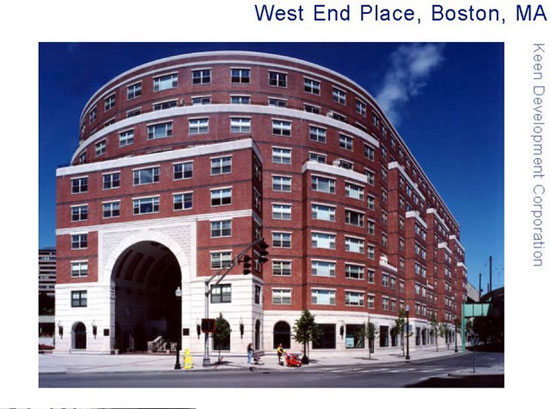
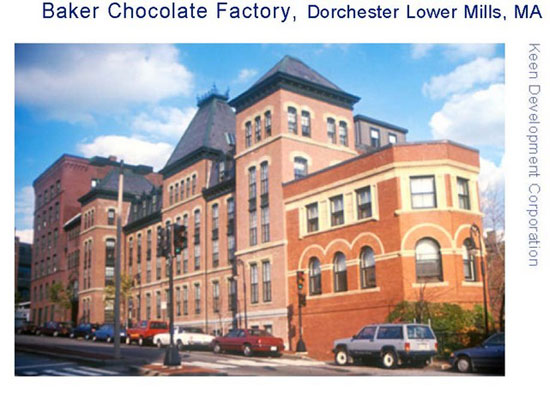
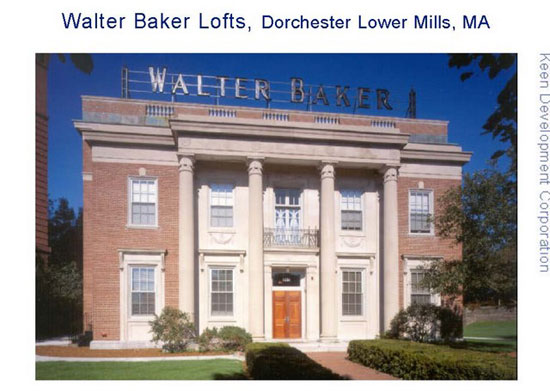
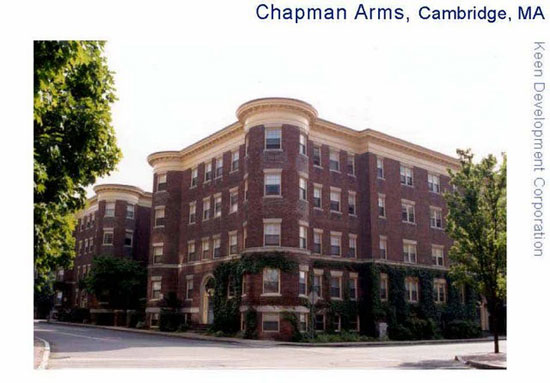
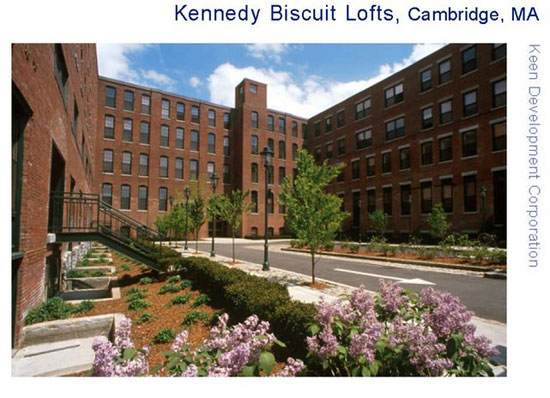
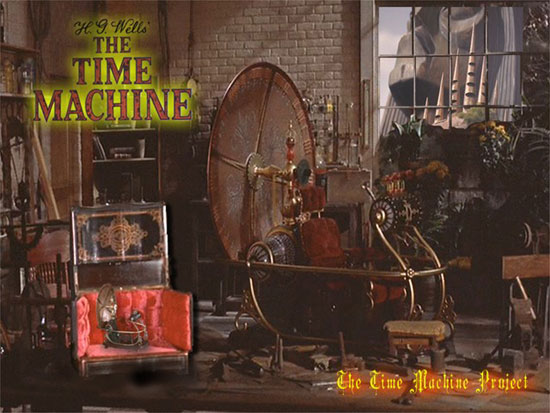
Remembrance of Bob Kuehn
by David A. Smith, Founder, Affordable Housing Institute
As I was heading home yesterday I saw
CHAPA's Aaron Gornstein, looking
grim and distant. He told me, to my shock, that Bob Kuehn of Keen
Development had died of a sudden heart attack. "And I saw him just this
morning," Aaron said mournfully.
At Bob's gala 60th birthday party ― held, fittingly enough, in Upstairs on
the Square, a Harvard Square restaurant housed in a historic rehab building
― were displayed two blown-up photographs: one of a tall slim young man,
pink-cheeked and bright-faced, labeled New Construction; beside it another
of the same man thirty-five years later, gray-bearded, broader of beam,
clothing in rumpled woolly disarray, similarly smiling, labeled Historic
Rehab. For that was Bob's passion, the rehab of historic buildings, their
transformation from abandoned anachronisms into adaptively reused jewels. If
Bob had been a hindu deity, his avatar would have been a filigreed weathered
brick.
In the early Seventies, when Bob was starting his career after being trained
(Yale, twice) as an architect and urban planner, most people thought of
'subsidized housing' (as it was then called) as a shoebox into which an
inert tenant was dropped, and through which subsidy was pumped. They were
people storage, no more. Bob was one of those who changed our thinking,
demanding in every one of his properties that the building's character, its
exoskeletal personality, be respected.
Affordability was for him a device, a financing tool that he deftly used,
the occupancy certainly a worthwhile use and good public policy ― Bob
compiled an impressive resume of service on umpteen advisory groups, panels,
and commissions ― but regardless of use, for Bob it was always about the
buildings. It was as if he were more winemaker than developer, seeking to
express each building's unique terroir. His unit mixes used to drive me to
distraction, since they always overflowed any standardized input grid I
designed. He seemed to take it as a point of puckish pride that every
apartment should have a different square footage and hence a different rent.
After all, would you dress all your children in identical clothing?
He never tired of showcasing the buildings, and spoke of them fondly, as if
relating his children's accomplishments, always by their historical name ―
Baker Chocolate, Kennedy Biscuit (where the Fig Newton was invented),
Audubon. I have a feeling he saw lenders, investors, owners, and residents
all as ephemera from the building's perspective, flickering through a
scrolling calendar of days like leaves outside the force field of H. G.
Wells' Time Machine traveler, our buzzing activities simply an
economic energy field from which the buildings could draw sustenance and
life.
Fittingly, his office was in an ivy-covered Harvard Square historic rehab of
a formerly rent-controlled (and consequently decrepit and dying) building
that he had rehabbed into affordable housing.
When I posted about Max Kargman, Bob added his own appreciation: as with
most of his commentaries, it was wryly ursine, faintly self-deprecating,
respectful of history, and witty.
Too soon you left us, Bob. Too soon.
Remembrance of Bob Kuehn
by Jeremy Wood '64 at the memorial service in Boston on 6/21/06
What to think and feel at these moments ...
The courtyard of West End Place was completely filled with folks from all
over the Boston community whose lives Bob's friendship and good works
touched.
Sam Low delivered one of the eulogies at the Memorial. Joe and Carole
Wishcamper came down from Maine to attend. Doane Perry came and probably
others, whom I didn't see in the throngs of folks who came. Gerry Flannelly
attended, together with four more of Bob's North High School (Minneapolis)
classmates.
We have lost a dear friend, a truly great and goodly man, who indeed was
more like a force of nature. If he had been a Japanese, he surely would been
recognized as a national treasure. He got amazing and impossible things done
hereabouts, truly left this world a better place than he found it.
Best for us to carry on, follow his example and work to do the same.
May we all keep well and stay in touch.
Remembrance of Bob Kuehn
by Joe Wishcamper '64
I didn't know Bob Kuehn at Yale. I first met him in New York in the
summer of 1967, sharing an apartment on West 103 Street with Bruce Driver,
Gerry Shea and others. Bob had just graduated from Yale Architecture School
and worked for a community renewal agency in Harlem. We quickly became fast
friends. Our paths converged again a couple of years later after we both had
moved to Cambridge, where Bob and Martin Padley, both of whom were single,
spent nearly every weekend night eating and drinking with Carol and me. We
became an extended family of a sort. Bob serially went out with every one of
Carol's female friends. In those days, he was a handsome 6'5" trim and
charming guy. We spent considerable time together with other classmates,
including Jim Rogers, Toby Hubbard, Blaine Krickl and Sam Low.
When I looked to make a career change in 1970, Bob arranged a job for me
with a housing developer for whom he worked, thereby helping launch my
35-year career in housing development. Later, Padley followed us both to the
same company, beginning his long career in real-estate public relations.
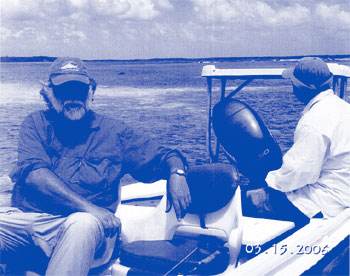
After
I moved to Maine in 1977, Bob and I stayed close through fly fishing. We
spent at least a week every year flats fishing in the Florida Keys and the
Bahamas for bonefish and tarpon. Bob eventually bought a house in Key West
where he generously hosted fishing friends.
For all the years I knew him, Bob was an enigmatic person. He was a quiet
man and an accepting, uncritical friend. Yet in business he could be
stubborn and difficult. He was a loyal friend with a number of lifelong male
friendships, yet he had difficult and ultimately unsuccessful relationships
with women. He married once, for a very short time, but never remarried or
had children. Yet, he was warm and avuncular to my kids and those of his
other friends. He died with no heirs except a brother.
Later in life, Bob became increasingly neglectful of his physical
well-being. Since I became something of a health fanatic, we used to tease
each other about being at opposite ends of the self-care spectrum. Two or
three years ago Bob wrote in the 1964 class notes in the Yale Alumni
Magazine of a bet we made as to who would outlive the other, New Age Man or
Retro Man; the former, obsessively working out, eating properly, eschewing
alcohol and tobacco, belonging to men's groups, meditating and doing yoga;
the latter, smoking cigars, drinking too much, eating pizza and Beef
Wellington, abhorring exercise, belonging to a poker group.
In July, Bob died of a massive heart attack while working at his desk. A few
days after an emotional service of remembrance, I received a letter from his
attorney advising that Bob's will contains a provision asking that I not
gloat over winning the bet. It is for certain that I'm not gloating. I think
about Bob almost every day and only in retrospect do I realize how fond I
was of him and how deeply connected our lives were for nearly forty years.
Remembrance of Bob Kuehn
by John Dobkin '64
I was sorry to read of Bob Kuehn's death in the current Yale Alumni
Magazine.
I knew Bob well at Yale and got to know him even better in 1964-1965.
He was studying in London and I in Paris. In those days one found classified
ads on the front page of the London Times. There, tucked in among
others, was the following announcement: London to Karachi, 45 pounds.
Bob and I signed up and met the bus in the outskirts of London. It was April
of 1965. The bus was a 1945 vintage, and the passengers had brought along
all of their belongings ― bedding, food, cooking utensils ― for their trip
home. The bus broke down three times between London and the Channel. Bob and
I left, got 43 pounds returned, and hitched to Bombay and then on to Kabul.
In those days the trip was possible. We were among the first hitchhikers,
before the waves that were to hit Katmandu. Iran was open and fascinating.
We had a trouble-free and fascinating time. We were well received and even
looked after all along the way. Bob tended toward the methodical. He'd spend
2 days trying to find someone who could mend his boots. I tended toward the
more relaxed. Some of our happiest moments occurred when we sighted our old
bus. We saw it in Bulgaria. We saw in outside Isfahan, as we were waiting at
an oasis for a lift. Many of the towns in Pakistan that one reads of now we
visited, and happily.
We ran out of steam in Kabul. After spending a week there, living with the
head of the Alliance Française and his family, we exchanged dollars at a
very reasonable rate, and flew to Tashkent and then on to Moscow.
(The alternative would have been to move through Afghanistan and west.
We had been on the road for over three months. It was summer and it was hot.
Another two months on the road was not terribly appealing.)
From there I returned by train to Paris, where I was expected, and I believe
that Bob went on to St. Petersburg. We saw one another occasionally. He met,
knew and liked his wife. By then I had moved to Washington and we lost
touch. But the memories of the trip have held fast. And it is a pity that he
and I cannot reminisce.

